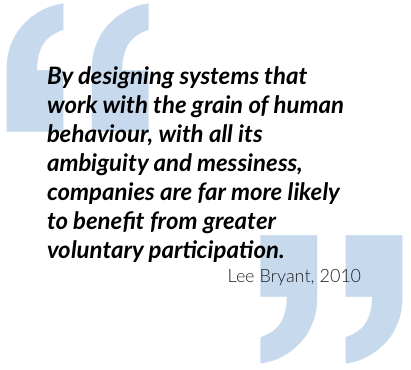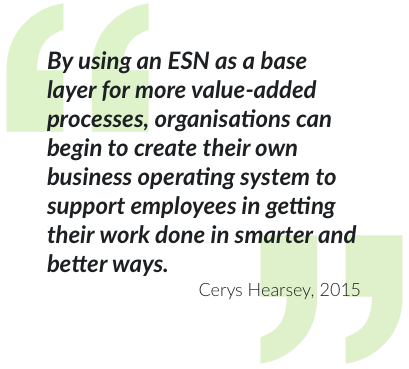Design
Digital Workplace Futures
Design is a very important issue for the digital workplace, as weaning people off email and onto better sharing platforms must make it easier, not harder to get their work done. Habits are heard to break.
Early social platforms were designed in a very tech-centric way, with little understanding of how they would use used in different contexts. Later, they became more user-centric and adaptable to different contexts and use cases.
More recently, digital workplace platforms and apps have become more value-centric and built around known use cases for sharing and collaboration.
Looking to the future, it seems we still have design lessons to learn from the early days of social computing, but we must do better to integrate more tools and data if the digital workplace is truly to become ‘where work happens’ rather than where we talk about work.
> Introduction
> Technology
> Ownership
> Community
> Design
> Collaboration
> Skills
> Change Agents
> Leadership
> Org Structure
> Measurement
> Conclusion
- SHIFT 1: Tech-centric
- SHIFT 2: User-centric
- SHIFT 3: Value-centric
- NEXT: Highly Integrated
- SHIFT 1: Tech-centric
In the early days of hand-crafted toolsets, the end user experience was driven entirely by features offered by technology. The first communities and collaboration spaces were empty when launched and hard for users to get started with – this was particularly true for tools like wikis, where employees were often intimidated by a blank page and lack of structure.
Only technology teams and isolated enthusiasts were able to make head way with wikis that had light-weight code interfaces and lots of confusing drop down menus. Blogs were for the few, and often curated by internal communications. Those that emerged from teams or individuals tended to be buried out of sight and on specialist or niche subjects that took time to gain any kind of following. Unlike in the consumer world, return on time invested matters for employees in organisations, especially when senior leaders ask tricky questions about ‘new fangled tools’.
Despite the excitement caused by the introduction of systems of engagement such as collaboration tools, employees used only a small fraction of what was available and empty modules dominated home pages of communities leaving an impression of empty sites when new visitors did stumble across them.
This was a particular problem in early versions of Microsoft SharePoint, where site proliferation, poor search and terrible user experience led to a deeply embedded hatred of the tool that persists to this day.
Errr, nope! Because the focus is solely around tools and technologies we use and, to me, I still think we are missing a huge piece, the most important one, if ever: sociology. Without it, it's just our tech fetish kicking in again #PS_Salon
— Luis Suarez (@elsua) April 5, 2019
- SHIFT 2: User-centric
Bringing the concept of user-centred design to social tools was enabled by the introduction of big platforms such as Jive and IBM Connections. This allowed organisations to focus on real user need rather than feature-availability for the first time. User-centred design is an iterative discipline, and involves the user at every stage of development – this was a revelation for many teams that we worked with, allowing them to get hands on almost immediately, crafting their own experience with guidance. This also allowed super-users to better support their teams post-rollout. Having participated in the design process, they were perfectly placed to tweak habits & behaviour, as well as features.
As organisations became more advanced, best practice toolkits were created for simpler collaboration and community experiences. Hand-crafted experiences were reserved for very large communities or high-value spaces. Internal consulting teams were able to deliver simpler experiences that made adoption of new tools easier. This meant training efforts now focussed on use cases rather than click-by-click eLearning.
However, it became clear that users could not imagine what they had never seen, and therefore use case design was still lacking, and adoption plateaued.
- SHIFT 3: Value-centric
Many organisations have championed the concept of trying to meet the user where they are. This leads them to enable collaboration through integration with email systems and file shares. But this does not enable the true behaviour change organisations are seeking, nor does it allow employees to develop the deep digital skills they will need to succeed in the future of work.
A better approach is to leverage digital guide networks to constantly share success stories they hear from inside and outside the business of high-value communities. This brings inspiration to the organisation in a constant flow. This can then be fed into hackathons, where teams focus on the business as a product seeking to fix broken processes, create new ways of working and learn from cutting edge practices from internet-age companies.
Continuous improvement applied key service units within the organisation is also an excellent way to role model new possibilities. As teams focus on becoming services to the wider business, the design of the digital workplace needs to resemble their shop front, giving their service users the information they need to interact, highlighting value created for the organisation and gather service improvement ideas.
What needs to happen is to *finally* focus on a mindset shift where we start questioning the work we do, w/whom AND for what purpose. Tools are tools, enablers, but we need to redefine the purpose of WHY do we work & adjust accordingly. Tech + Sociology = Work Redefined #PS_Salon
— Luis Suarez (@elsua) April 5, 2019
- NEXT: Highly Integrated
The digital workplace is where people, technology, process and place come together. It is the primary day-to-day work interface for many, and therefore can be considered the frontline of the future of work.
The potential for a more confusing digital workplace landscape to emerge is ever-present, with the increasing number of tools with overlapping capabilities – this keeps design at the top of the agenda. A key priority for any Digital Workplace guiding coalition is to enable teams to design their own experiences based on coherent design principles and patterns, rather than build it on their behalf. They must seek to offer freedom within a framework.
We will see the focus of design efforts shift from the large-scale home-page/intranet design to enabling better designed, high-value creation team working areas. Identifying the most effective design patterns is a data-driven exercise, focused on enabling the right kinds of behaviour and interactions for any given team.
Organisations that enable employees to design their own experiences through a platform + apps approach to collaboration and communities allows a better fit to actual work activities, a more adaptable experience and does not divide the organisation between the more static service providers and the agile teams at the frontline, but seeks to show how their workflows create a whole-organisation feel to the digital workplace through design.


